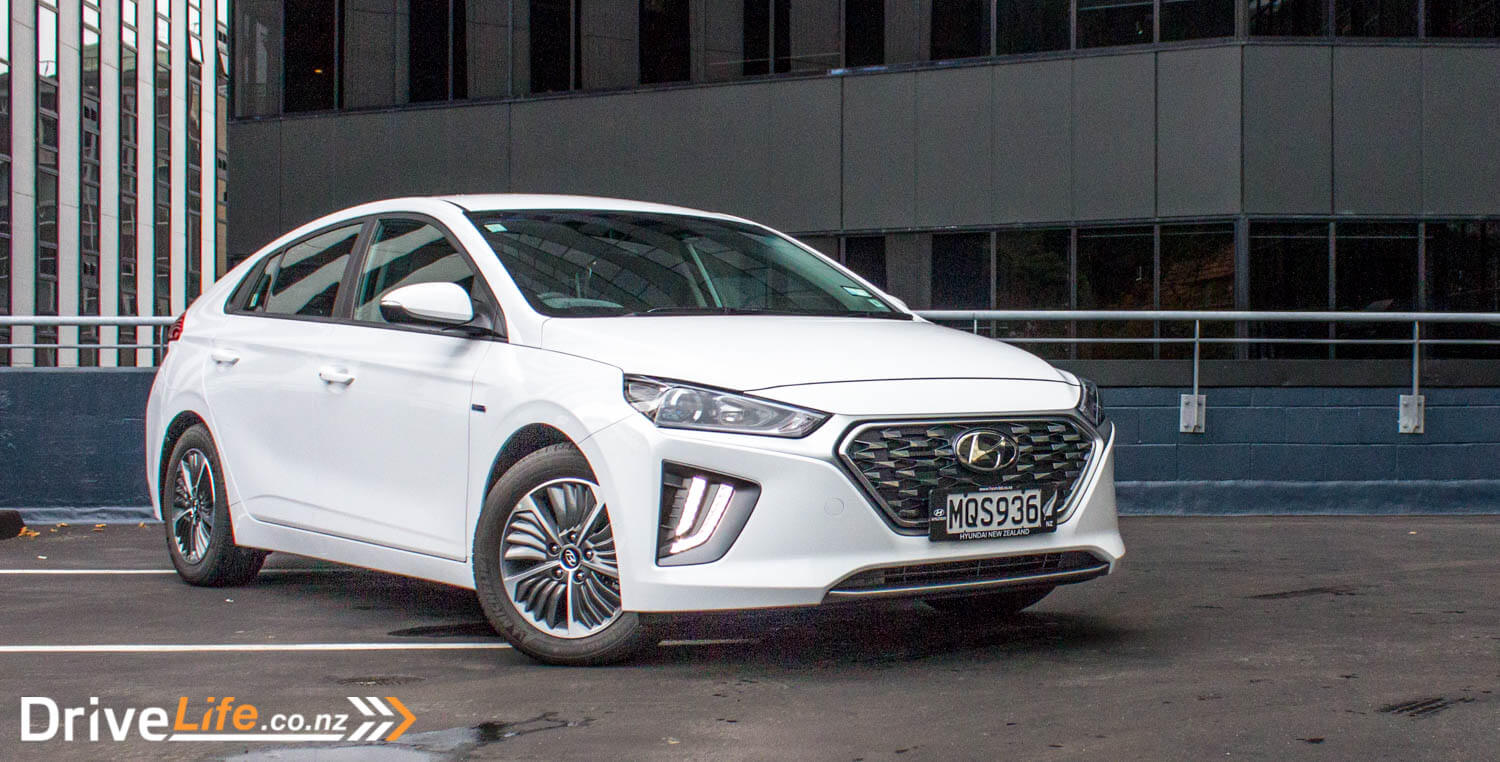We’ve said it before, and it’s worth saying again; a plug-in hybrid is a perfect stepping stone for those car buyers who are still fixated on how many kilometres they can get out of one charge. While the average New Zealand driver does 27km a day, there are still many that feel that to make a full EV worthy of considering, they need to be able to drive 500km without stopping.
For those car buyers, the plug-in hybrid is perfect. Driving a ‘normal’ hybrid will save you petrol, but with most plug-in hybrids (PHEVs) doing between 50 and 60km on a single charge, that’s all most people need for the Daily Drive.
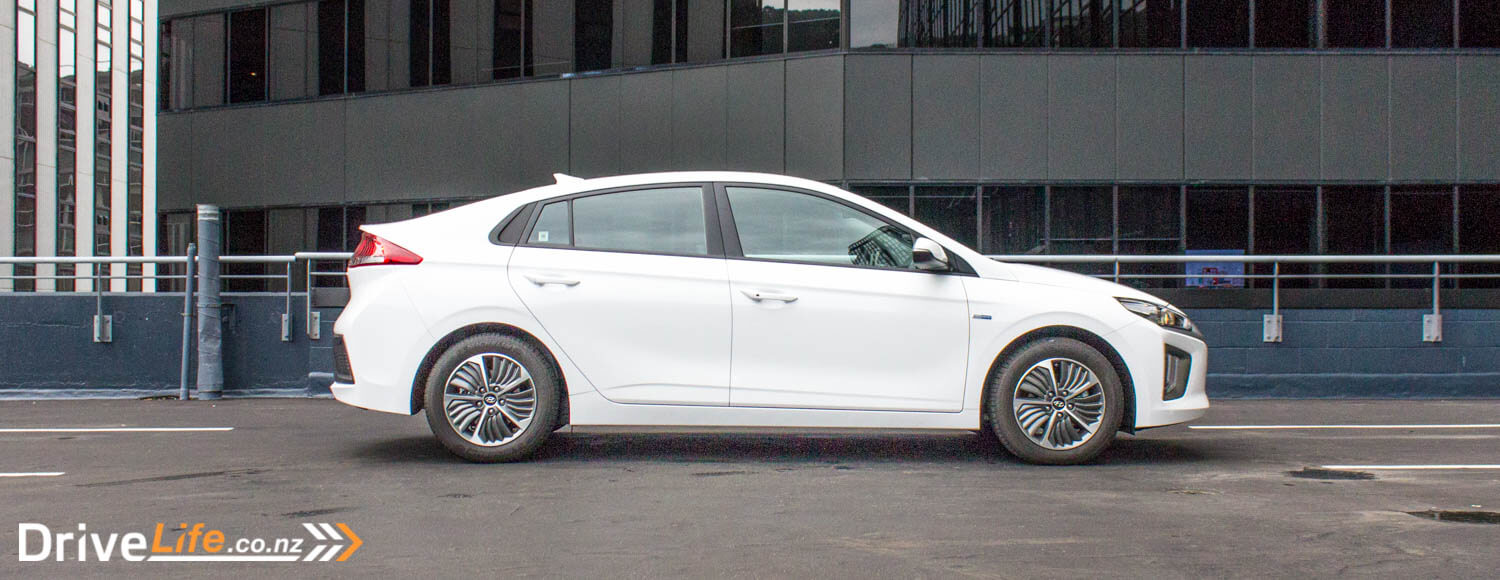
Of course, with a plug-in hybrid, that means you do still have an engine up front to charge your batteries and/or drive the front wheels when you do get low on charge. It’s almost the best of both worlds, and I have heard reports from one car dealer that some plug-in hybrids are coming in for a service, and the petrol has gone off in the tank. The people that are driving these cars simply don’t use petrol, instead relying on that EV-only range to get them through the day.
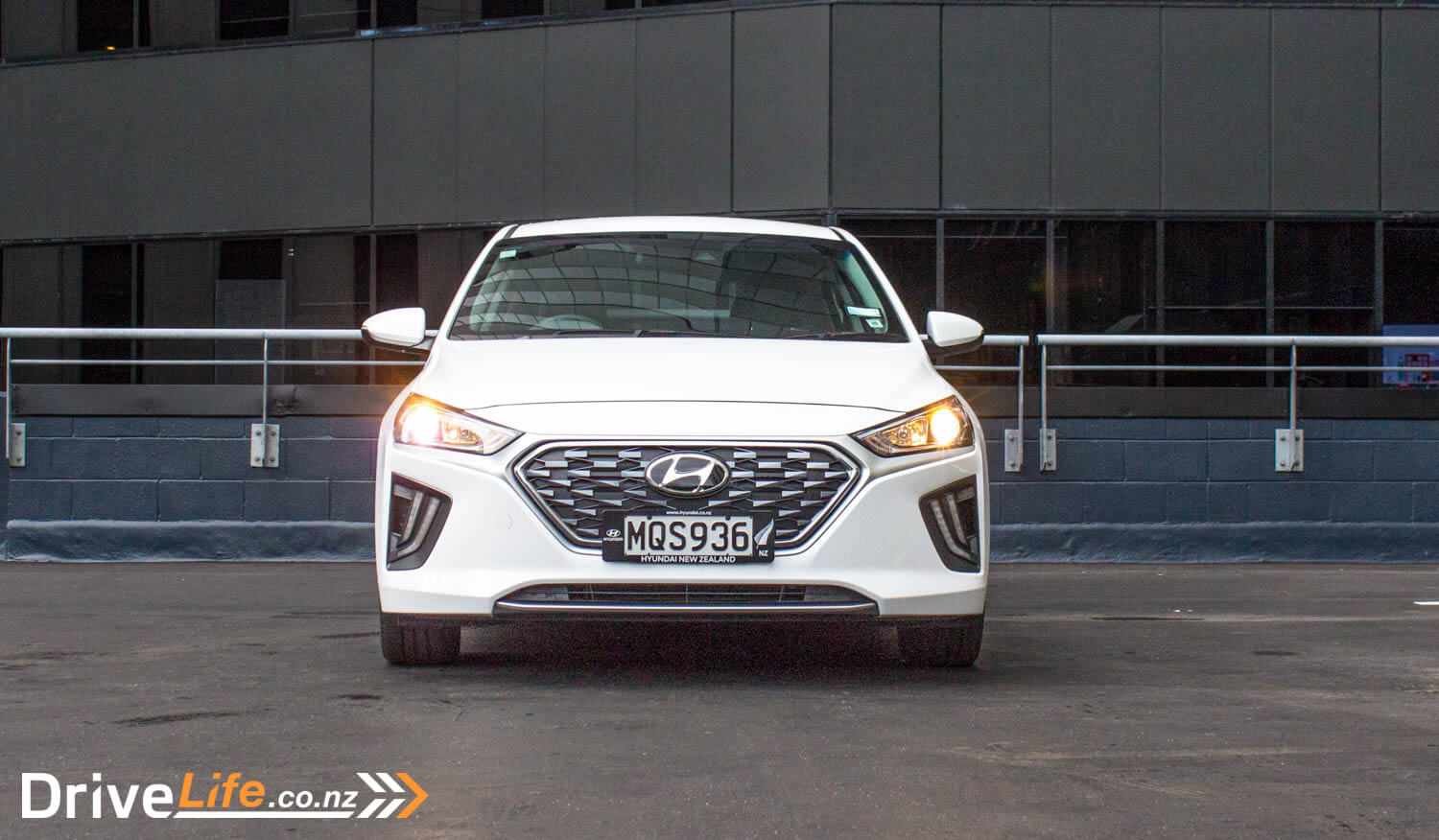
So what about the Hyundai Ioniq Plug-In Hybrid Vehicle (PHEV)? Hyundai broke new ground in 2016, by offering a hybrid, a plug-in (PHEV) hybrid, and a full EV – all in the Ioniq range. A brave move, and one that’s paid off.
2020 sees a new model Ioniq, and Hyundai sent us the new PHEV II model to test out. We tested both the hybrid and EV models in 2017 – time to see if the changes have been worthwhile.
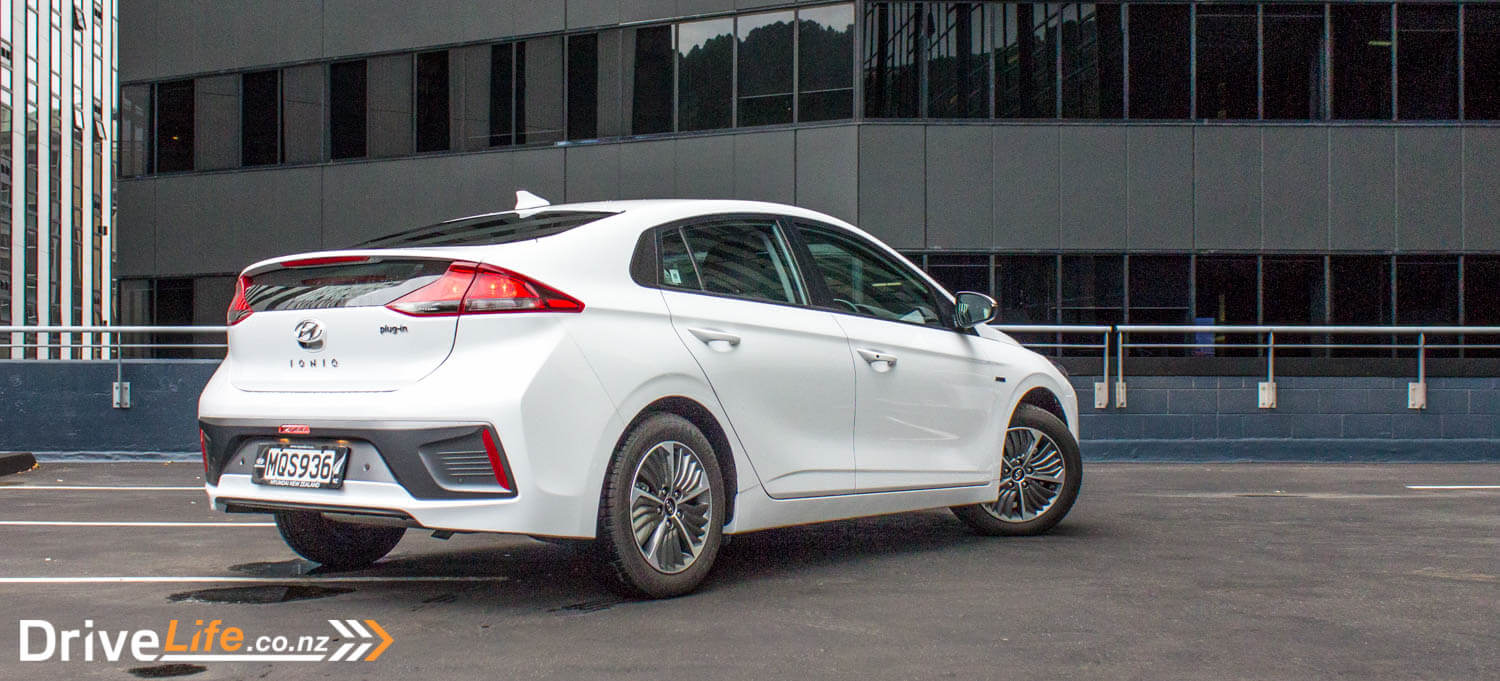
What’s In The 2020 Hyundai Ioniq Range?
There’s three models available as mentioned, and within each you can buy an Entry model, or upgrade to the Elite. All share the same 5-door hatchback body, with only the drivetrain otherwise separating them.
Focusing on the PHEV model, it is powered by a 1.6-litre, four-cylinder petrol engine with a power output of 77kW, and torque at 147Nm. There is of course an electric motor to drive the car too, that has an output of 44.5kW and 170Nm of torque. Attached to the petrol engine is a 6-speed dual-clutch automatic gearbox (DCT).
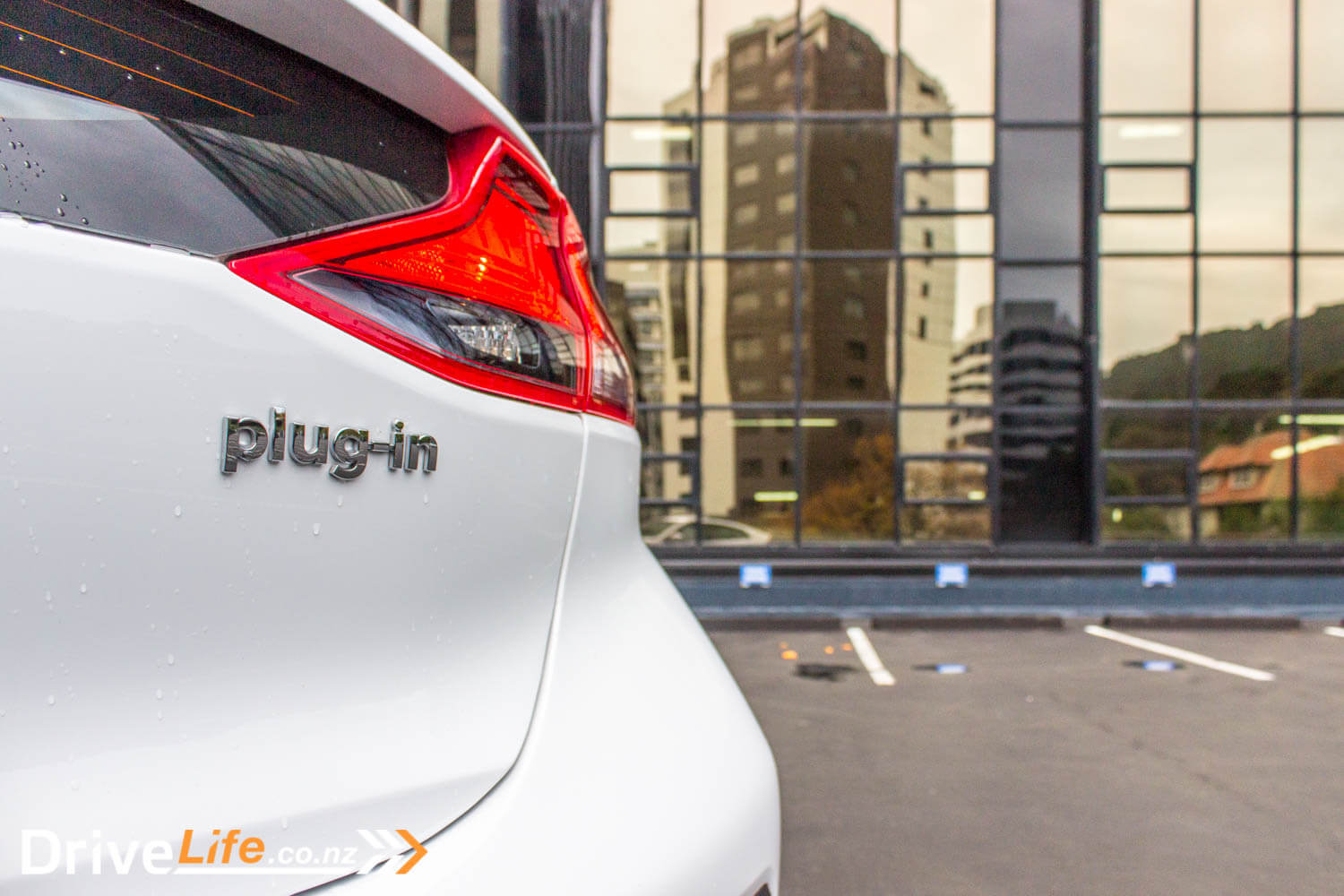
The base (Entry) PHEV has as standard an electric park brake with auto-hold, 7 airbags, adaptive cruise control, driver attention warning, lane keep assist, rear cross traffic alert, forward collision avoidance, a tyre pressure monitoring system, automatic headlights, LED DRLs, rear parking sensors, heated side mirrors, a leather steering wheel and gear shift gaiter, keyless entry and start, an 8” colour touchscreen display, Apple CarPlay and Android Auto capability, and climate AC, at a cost of $53,990.
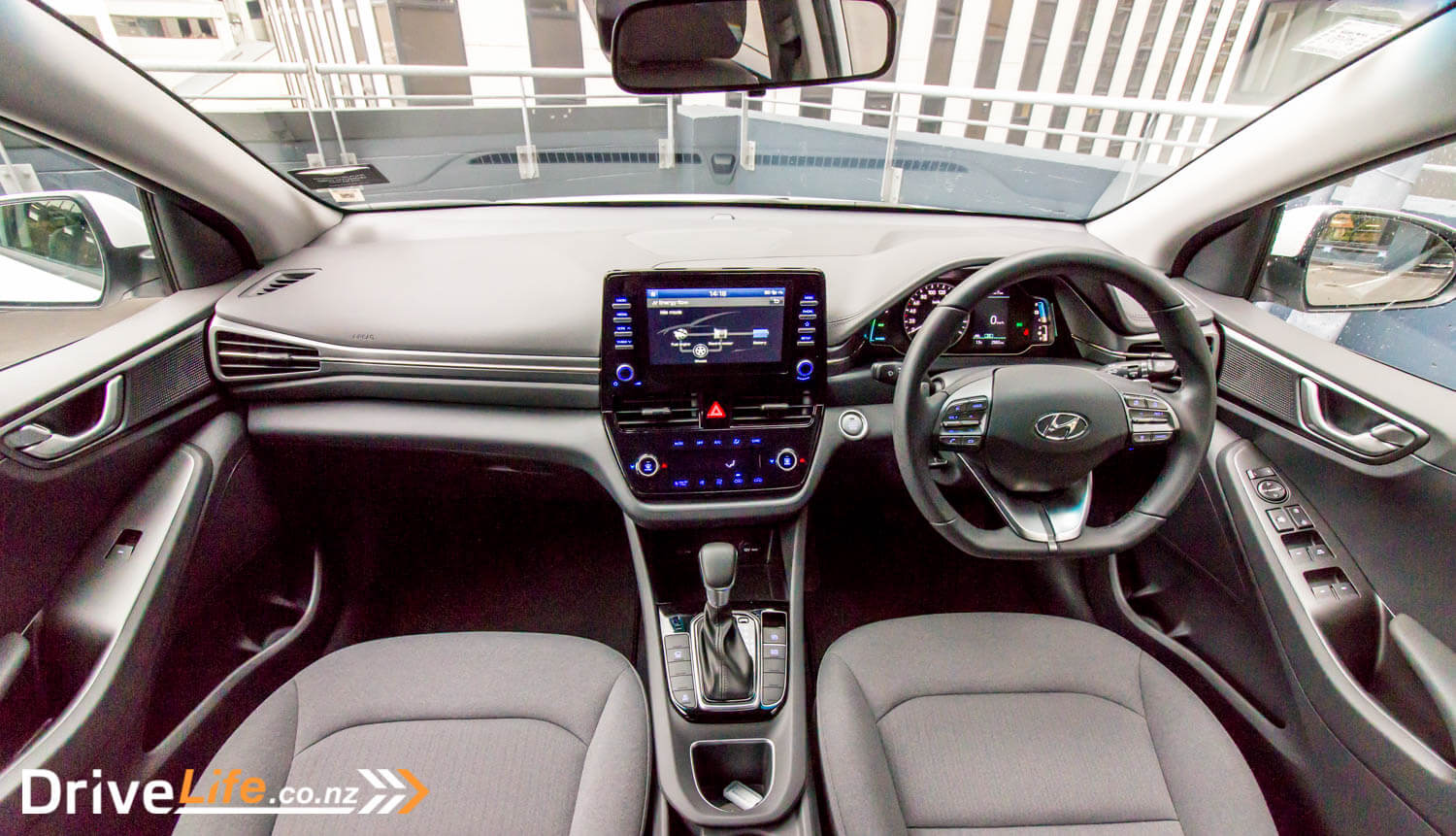
If you up-spec to the Elite PHEV model, this adds LED headlights and taillights, the Smart Welcome system, electrically folding side mirrors, leather seats, an electric driver’s seat with memory and electric lumbar adjust, heated front seats and steering wheel, wireless phone charging, a 10.25” touchscreen central display, SatNav with SUNA traffic updates, and an upgraded Infinity premium sound system with 8 speakers. The Elite model costs $59,990.
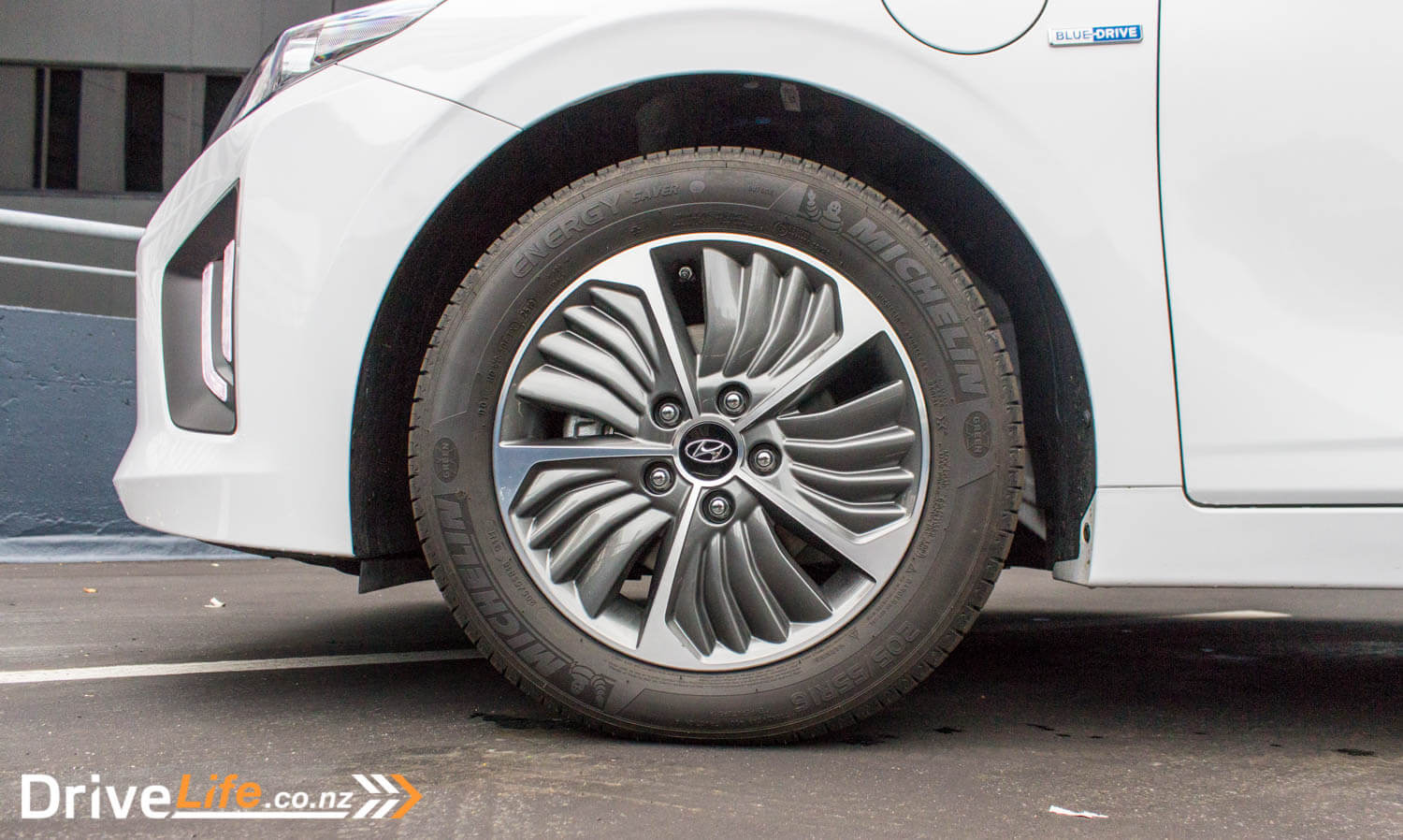
There’s a range of colours available, which are Polar White, Intense Blue, Typhoon Silver, Iron Grey, Fiery Red and Phantom Black.
You can read more about the Ioniq on Hyundai New Zealand’s website.
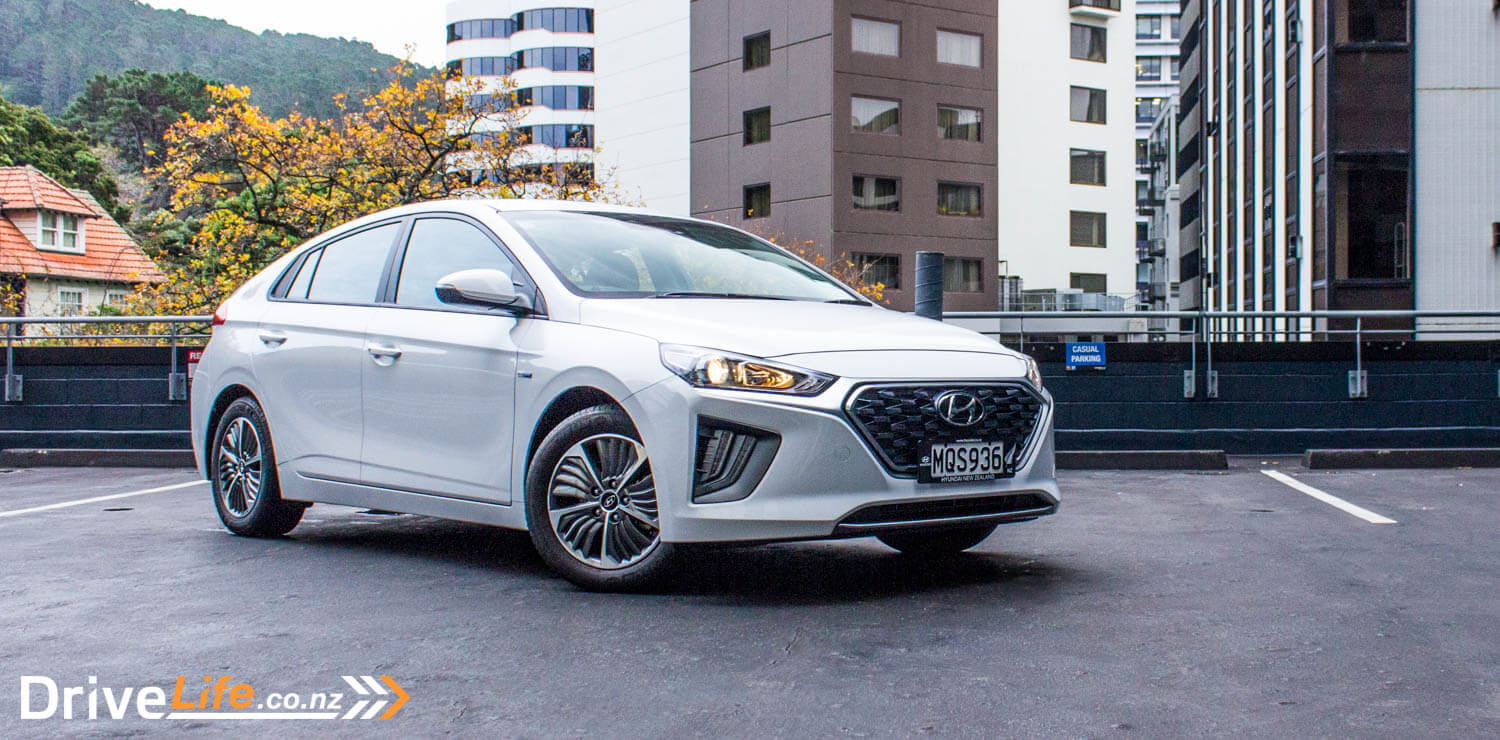
First Impressions of The 2020 Hyundai Ioniq PHEV Series II
There’s a definite face lift that’s happened here – the Ioniq has suddenly entered 2020, looking like it belongs. There wasn’t anything ‘wrong’ with the previous model, but this new one looks much more modern and current. Somehow it looks so much more streamlined than the previous generation, and has a certain smoothness about the body.
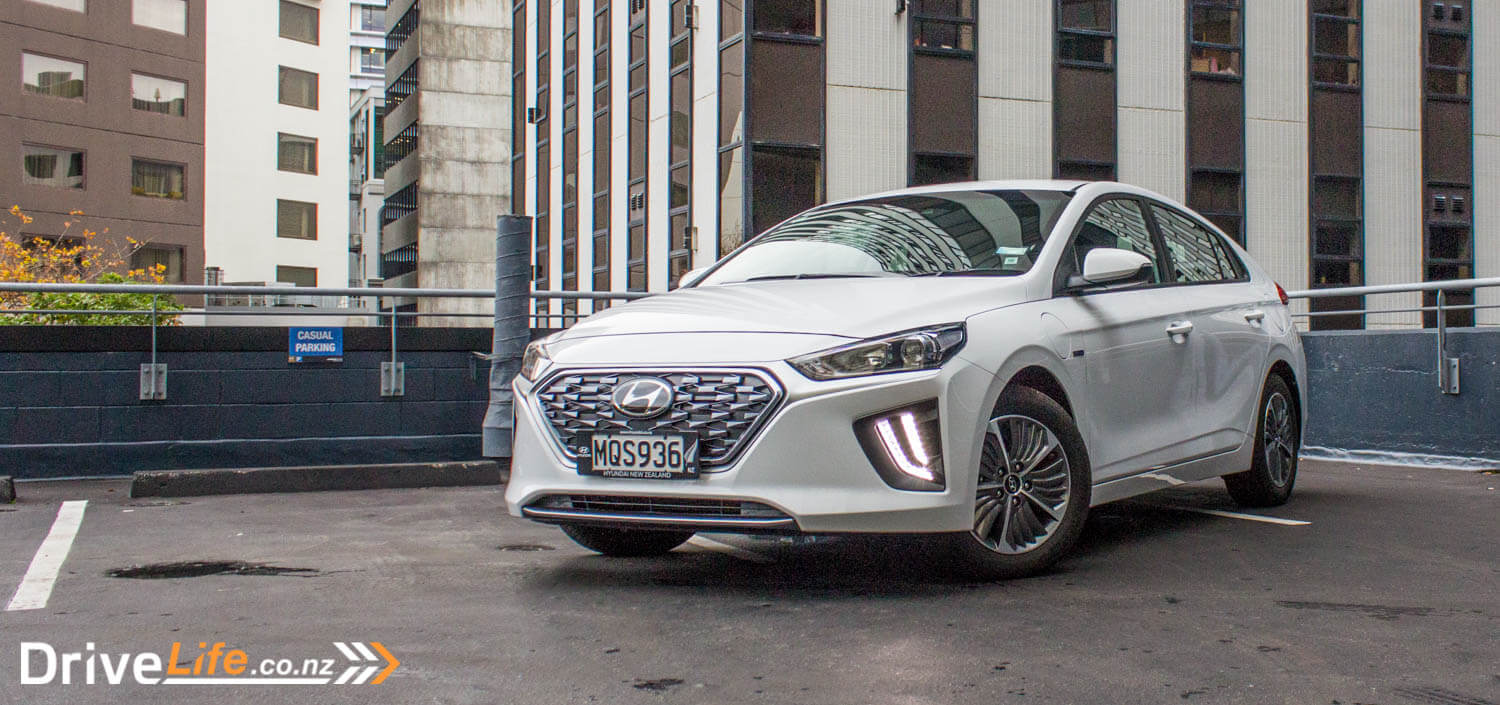
The rear end has come in for change too of course, and while it’s not as outlandish as the Prius Prime (another PHEV), it looks a little space age. I like it.
A shame Hyundai sent us a white Ioniq to review, so it can’t shake that taxi/Uber look, but still – a much better look than before.
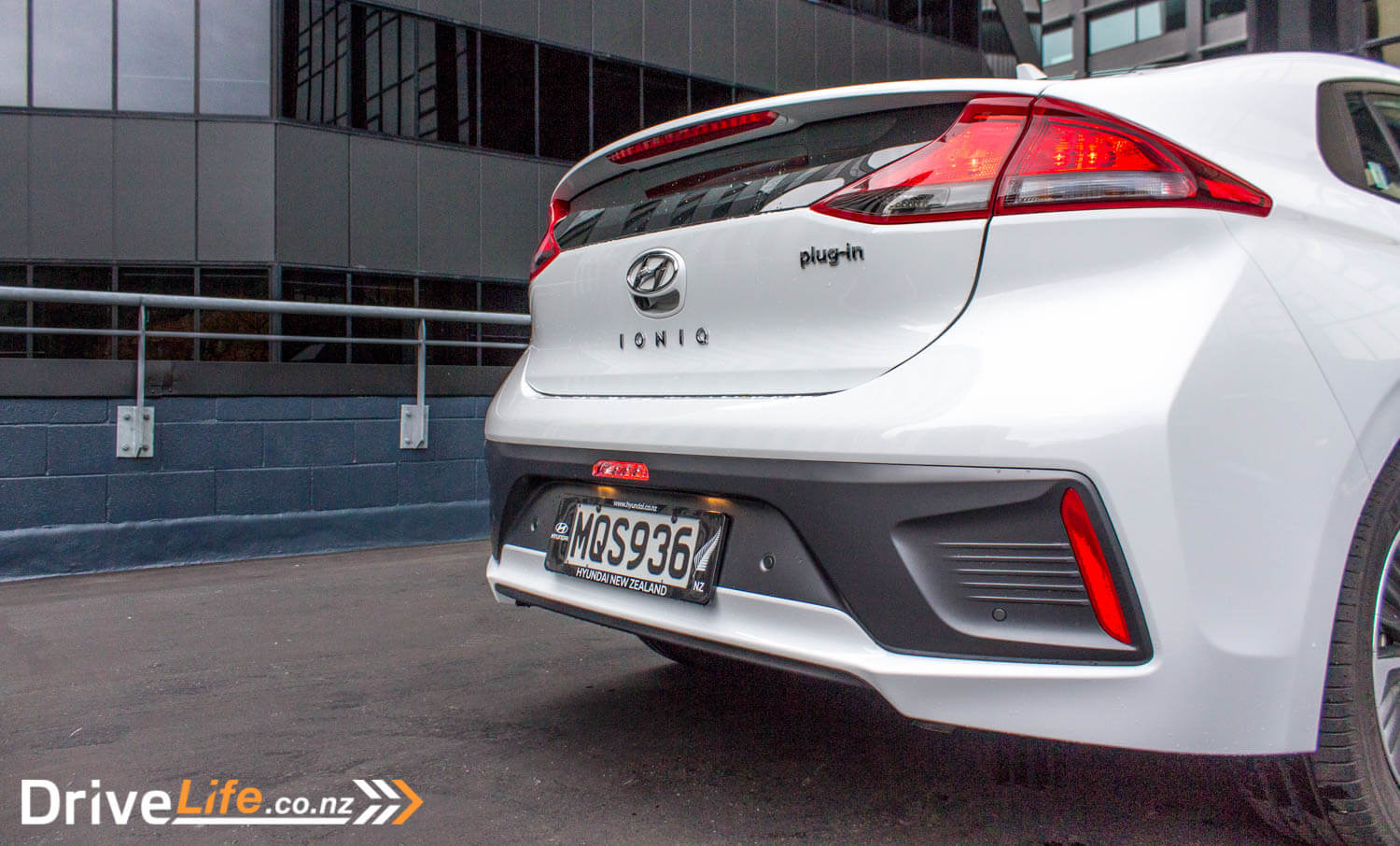
What’s The Interior Like On A 2020 Hyundai Ioniq PHEV Series II?
While the exterior looks fresh and modern, things on the inside are much more reserved. I won’t use the word ‘bland’, but it’s a struggle. The interior of the Ioniq is filled with hard plastics, just like the Hyundai Veloster I had dropped off. For $54,000, I expected a little more.
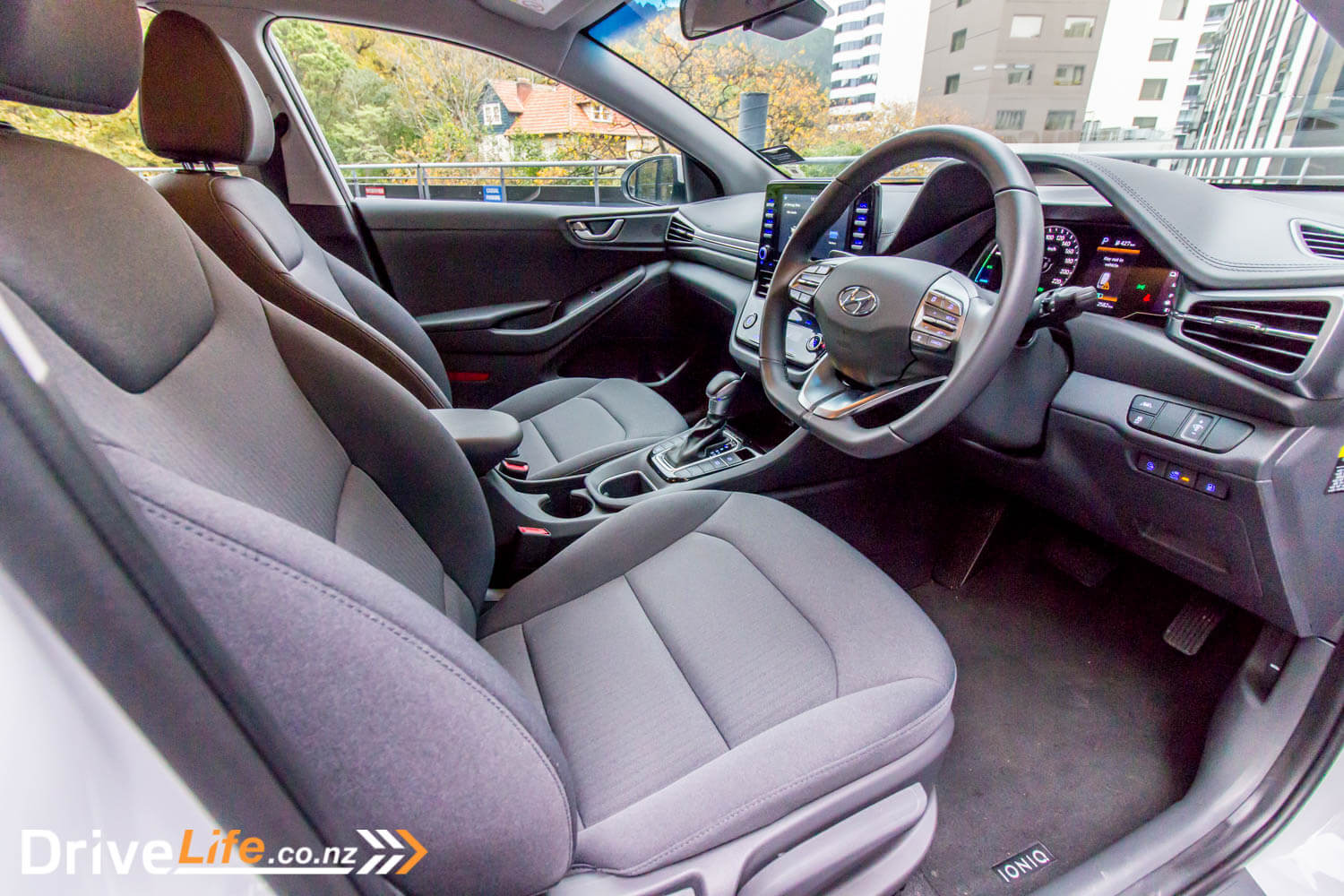
The interior is not bad, but it doesn’t have any sort of a ‘wow’ factor to it, in this technically-advanced car. The cloth seats don’t help here at all – I don’t mind cloth seats, but the colour and design of them added to the feeling of basicness.
Regardless, it’s a functional interior. There’s a deep but small centre console cubby, you get a single USB port up front, along with two 12-volt ports. Weirdly, there’s no USB ports or even a 12-volt socket for rear passengers. We started seeing lots of cars catering for rear passengers in this way, but it seems to have fallen out of fashion, or something. Rear legroom is generous, so there shouldn’t be any complaints from your passengers on that front.
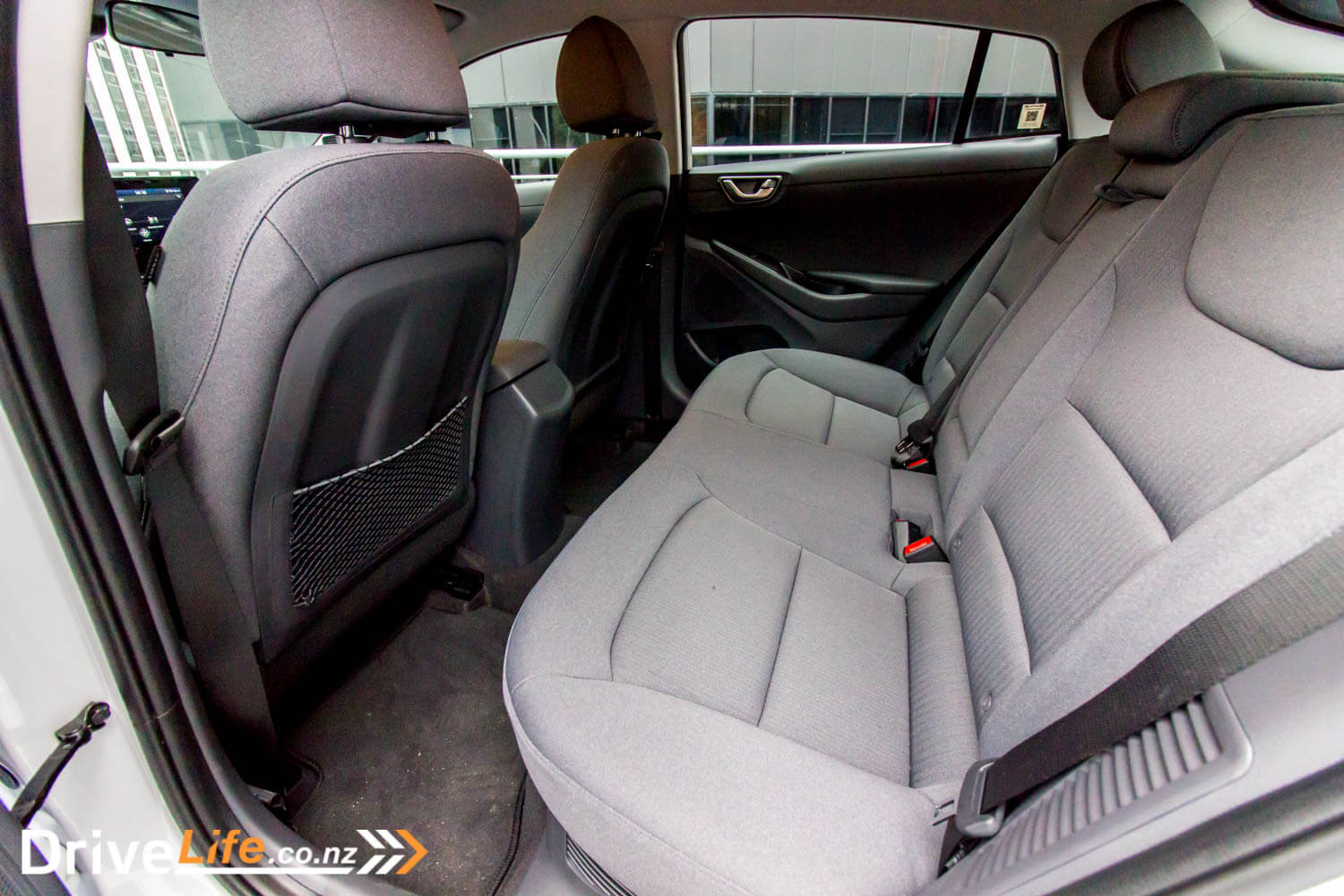
In the rear, there’s no spare under the floor, but you do get a pump for emergencies. Boot space itself is pretty decent at 341 litres.
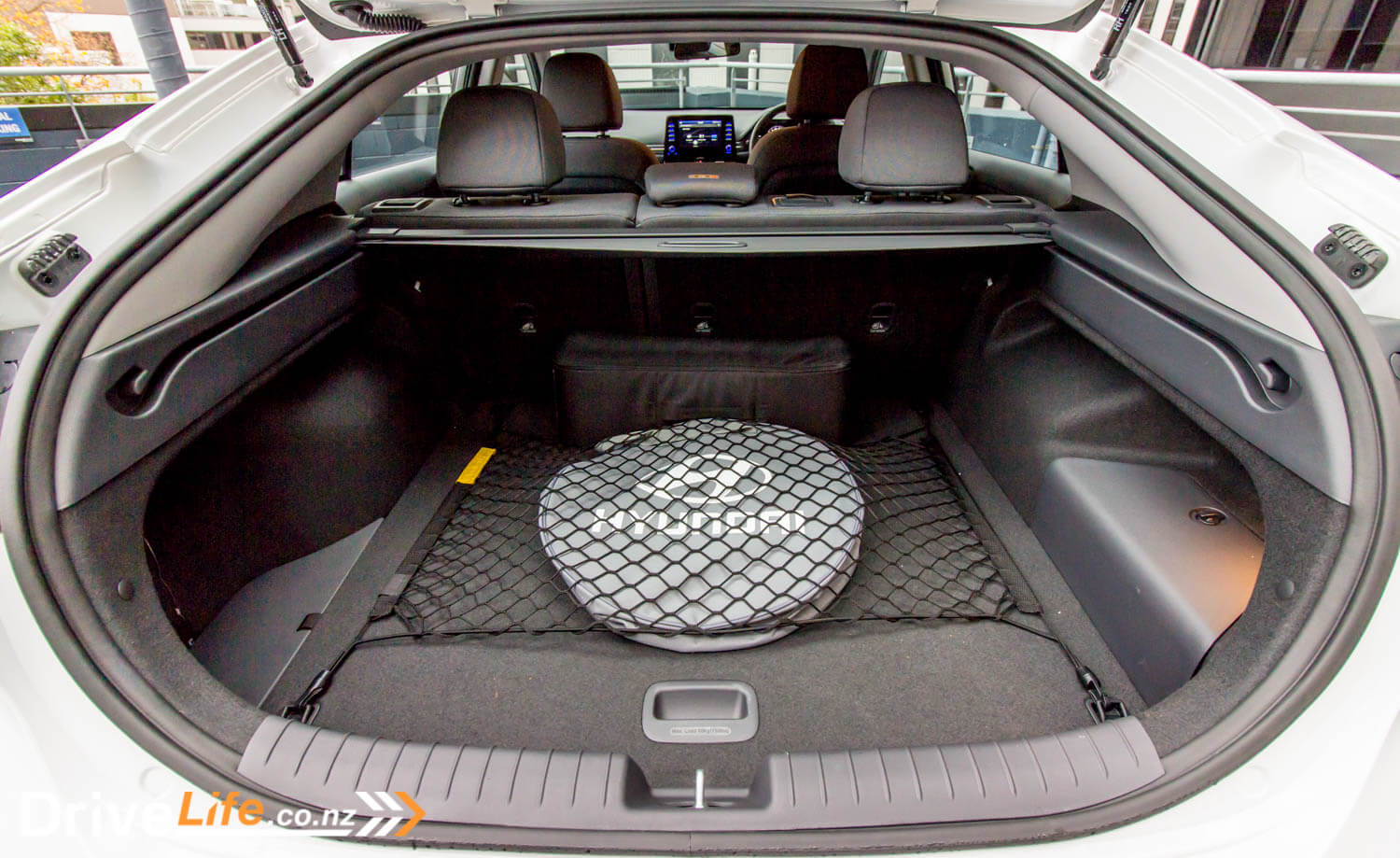
What Does The 2020 Hyundai Ioniq PHEV Series II Drive Like?
Dropping into the driver’s seat, it’s always good to see a “Driver only” AC button. That’s got to save some energy, surely. Like lots of PHEVs and EVs, the steering wheel paddles control brake regeneration, so you can adjust regen going down a hill to get that all-important charge back into the battery bank. Regen itself is pretty good, with three levels to choose from, and will eventually bring the car to a stop, even on the steepest hills I took the Ioniq on.
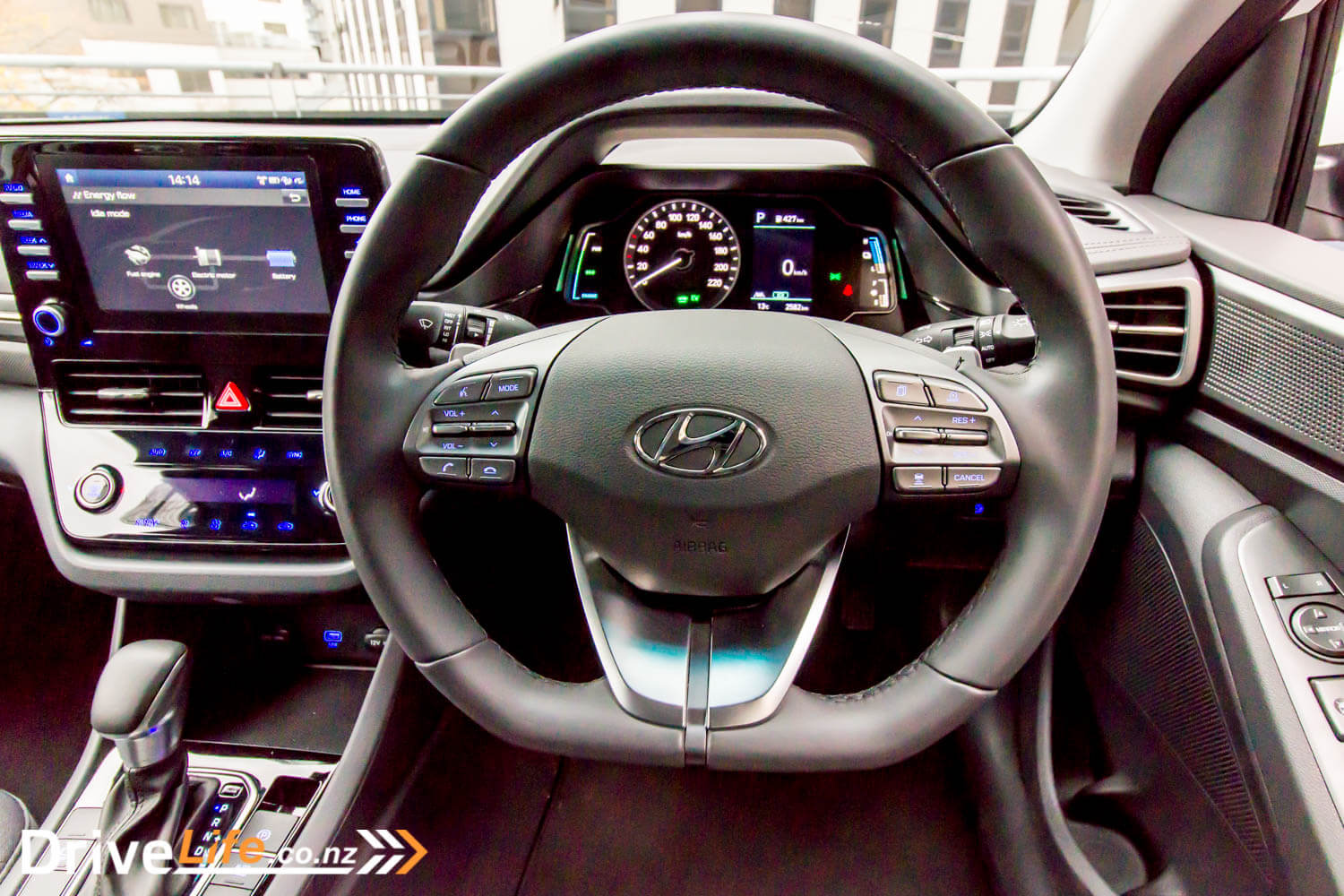
Understandably, the Ioniq PHEV defaults to Eco mode when you turn it on. There’s three PHEV drive modes to choose from; EV, Hybrid, and Automatic. EV should force the car to run only on the batteries, so you can make the most of that 50-odd kilometre range. Hybrid will run the car like a normal hybrid, and so if you are running in EV mode and the batteries get too low, the car will go into Hybrid mode automatically, starting the engine to put some charge into the battery bank.
Automatic mode does just that. It selects the mode for you. This will be a good option for most people who aren’t sure what mode to select.
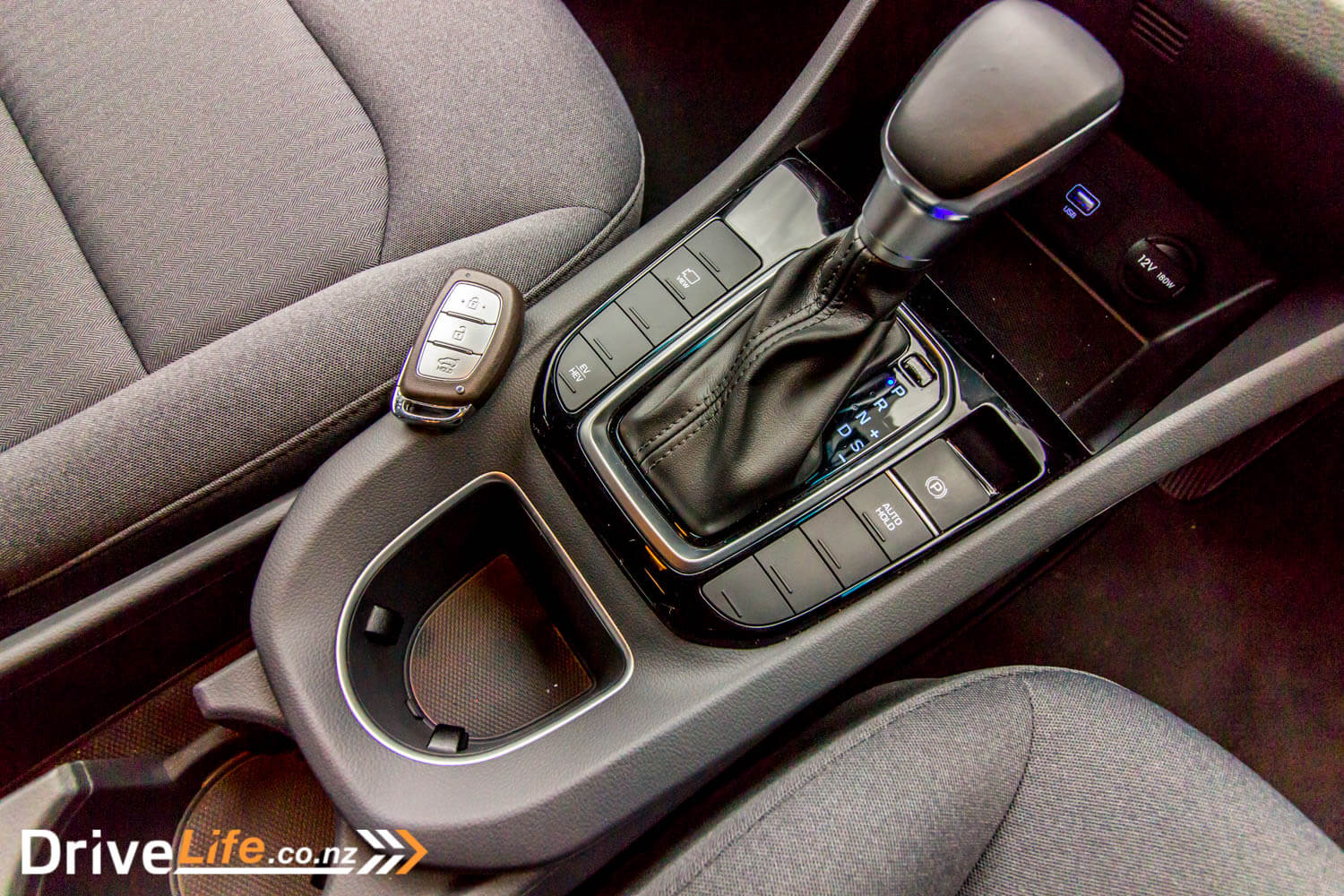
When I say EV mode should run the car on battery only, there’s a caveat to that. If you turn the AC, the engine will start regularly. Sometimes when leaving home with the AC on, the engine would stay running for 15 minutes. Not great for my fuel consumption. The Toyota Prius Prime, one of the Ioniq PHEV’s biggest competitors, also starts the engine, but only if you turned the front window demister on. It’s one of those things to keep in mind if you want to drive in battery-mode only to work and back. One day I braved 4 degree temperatures (so EV mode with no AC) for 55km, just to make sure I could get that far on a single charge. I did, but I was not loving the temperature inside. Hyundai says the car should get 52Km (that’s its WLTP rating) on a single charge, but I regularly got more than that, up to 10Km on a good day.
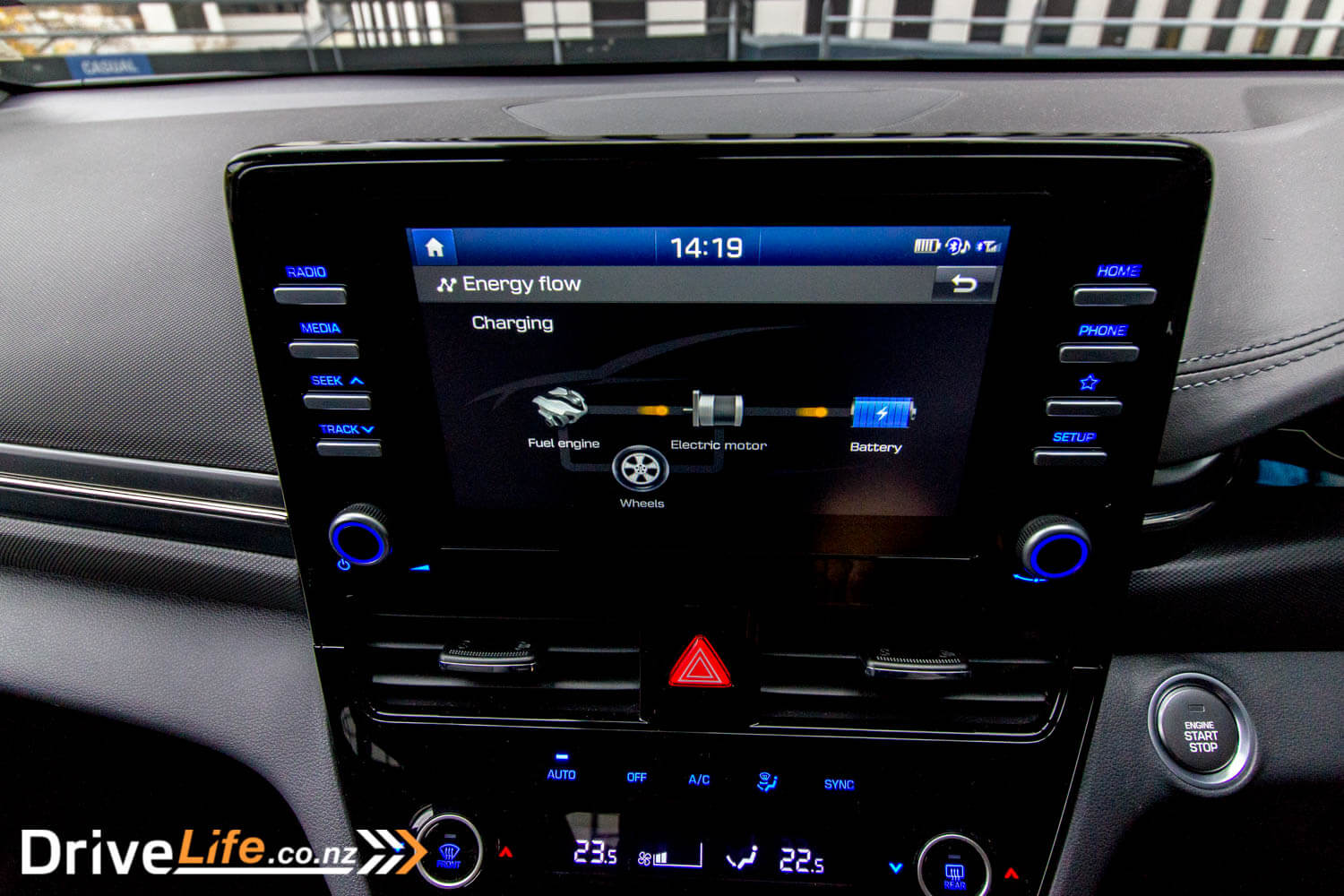
Doing that Daily Drive in EV and Eco Mode, the Ioniq PHEV isn’t a rocket, but content to cruise happily on the motorway. Like other EVs and PHEVs, running the car in Eco mode makes the gas pedal a lot harder to push down. It does save gas, I’m sure, but it can get a bit weary after a while. You do have an option though – stick the car into Sport mode. I have to admit, I spent some time looking for the Sport mode button, but couldn’t find it. Then I realised you simply move the lever right to put the transmission into manual mode, and the Ioniq automatically slips into Sport mode. You’ll get a couple of red bars on the side of the dash, and now the paddles that did control regen instead control gear changes, in the DCT automatic transmission.
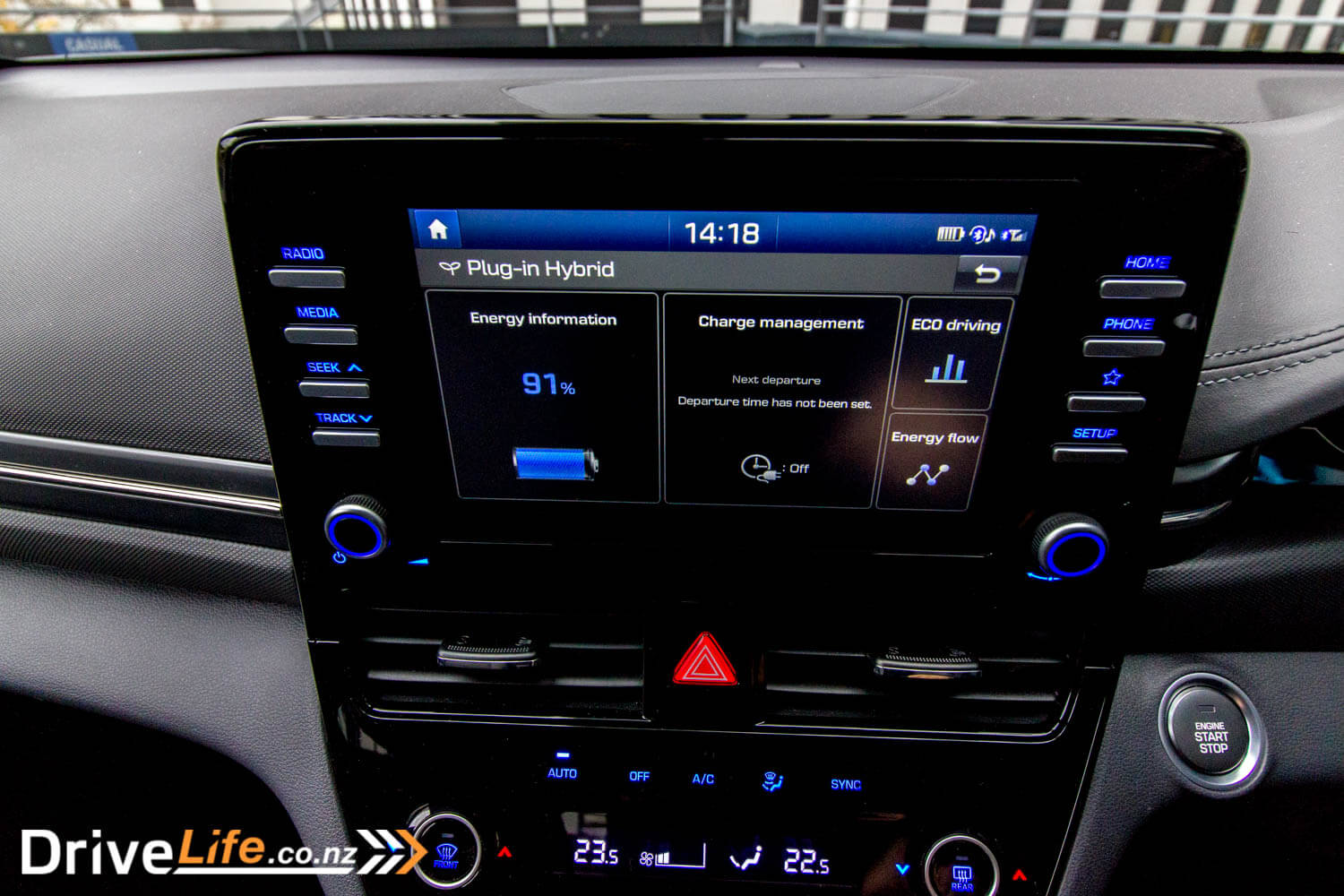
There’s another sign you can’t miss that you are in Sport mode: instantly, the car changes character, and is ready to shoot forward. And shoot forward it does. Acceleration from a standstill is excellent, with a little bit of tyre chirp (enough to be fun) and then it’s off, leaving other traffic in its wake. It really is a ball off the mark, in Sport mode. Mid-range acceleration isn’t quite as peppy, but it’s still far better than in straight EV mode. There’s just a little 1.6-litre petrol engine up front of the PHEV, but it’s still surprising how well it gets up and boogies in Sport mode. It’s grin worthy stuff, and it should be, since the combined torque rating of petrol engine + electric motor = over 300Nm.
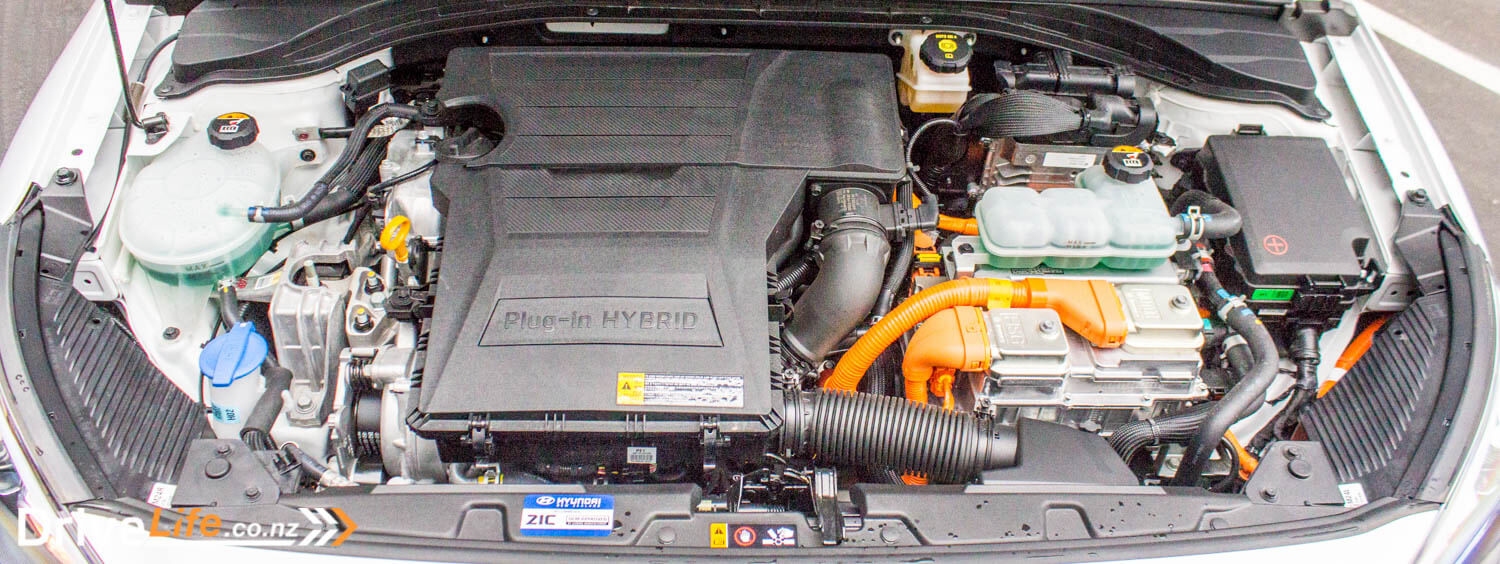
Other than performance in Sport mode, there’s some other great features that make the Ioniq PHEV a great motorway commuter. The interior is incredibly airy and bright, with large side windows helping hugely. The colour of the seats helps lift the interior too, and it’s so very bright inside, especially after the Veloster I had just dropped off. The C pillar is still a little chunky, and there’s no blind spot monitoring in the Entry model, so that keeps it slightly away from being perfect for visibility. Other niceties including an audible warning if the car in front of you has moved off – not that you’d be on your phone, but handy all the same, and the central display has good resolution and it’s not too laggy either. There’s an electric park brake, something that I always appreciate. Tyre noise is low, as is wind noise. The Ioniq PHEV really is a great commuter.
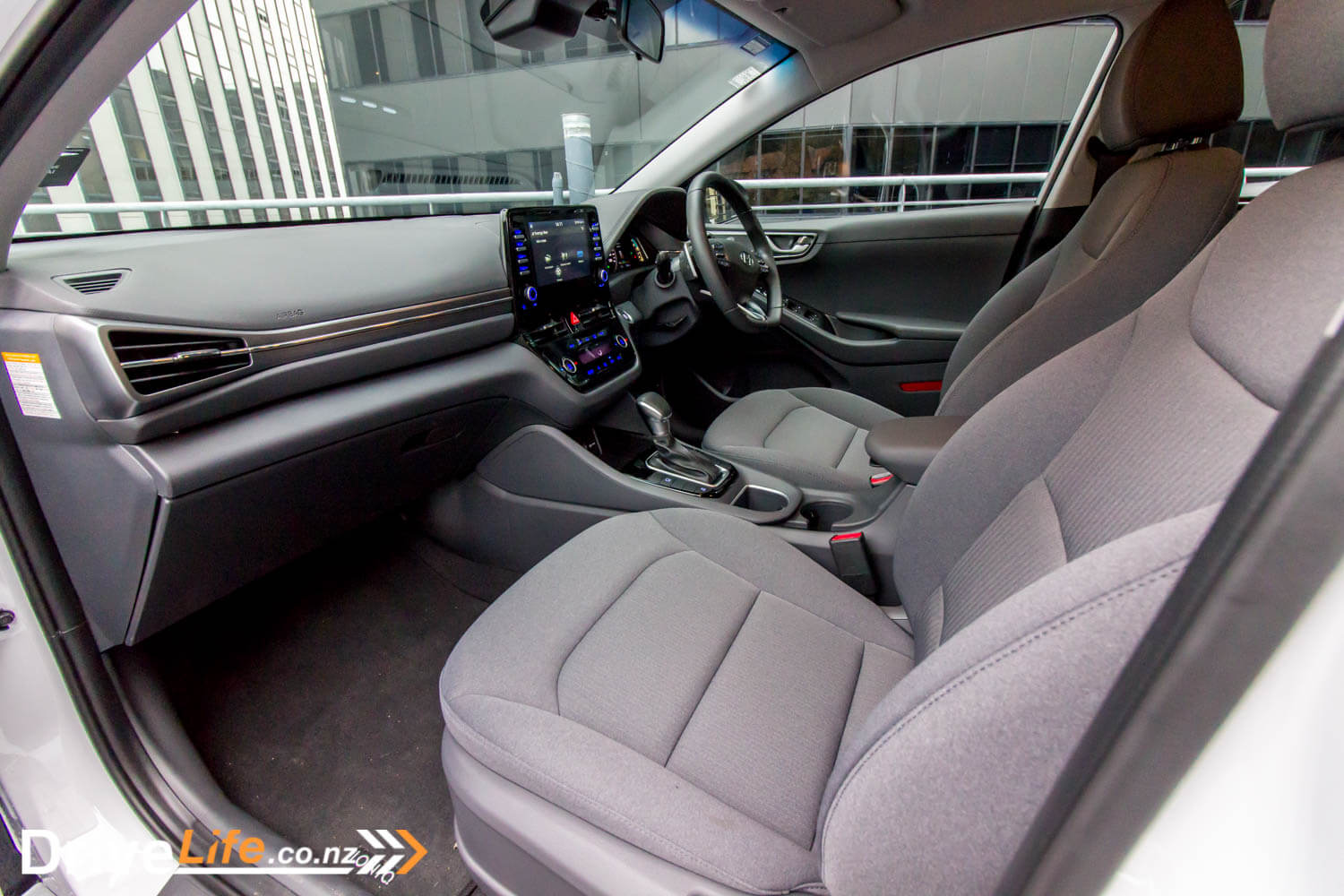
Not perfect though. I found that the top half of the split rear window doesn’t actually demist at all – only the lower half does. That leaves a big chunk of the window you really need to demist, undemisted. There are wires in the top half, but they are the radio aerial. There’s no rear wiper either, which doesn’t help.
Ride quality is a highlight, and I see that the new 2020 model has had some chassis and suspension work, and it’s paid off. We’re getting Australian-spec suspension here, and it is a dream to drive.
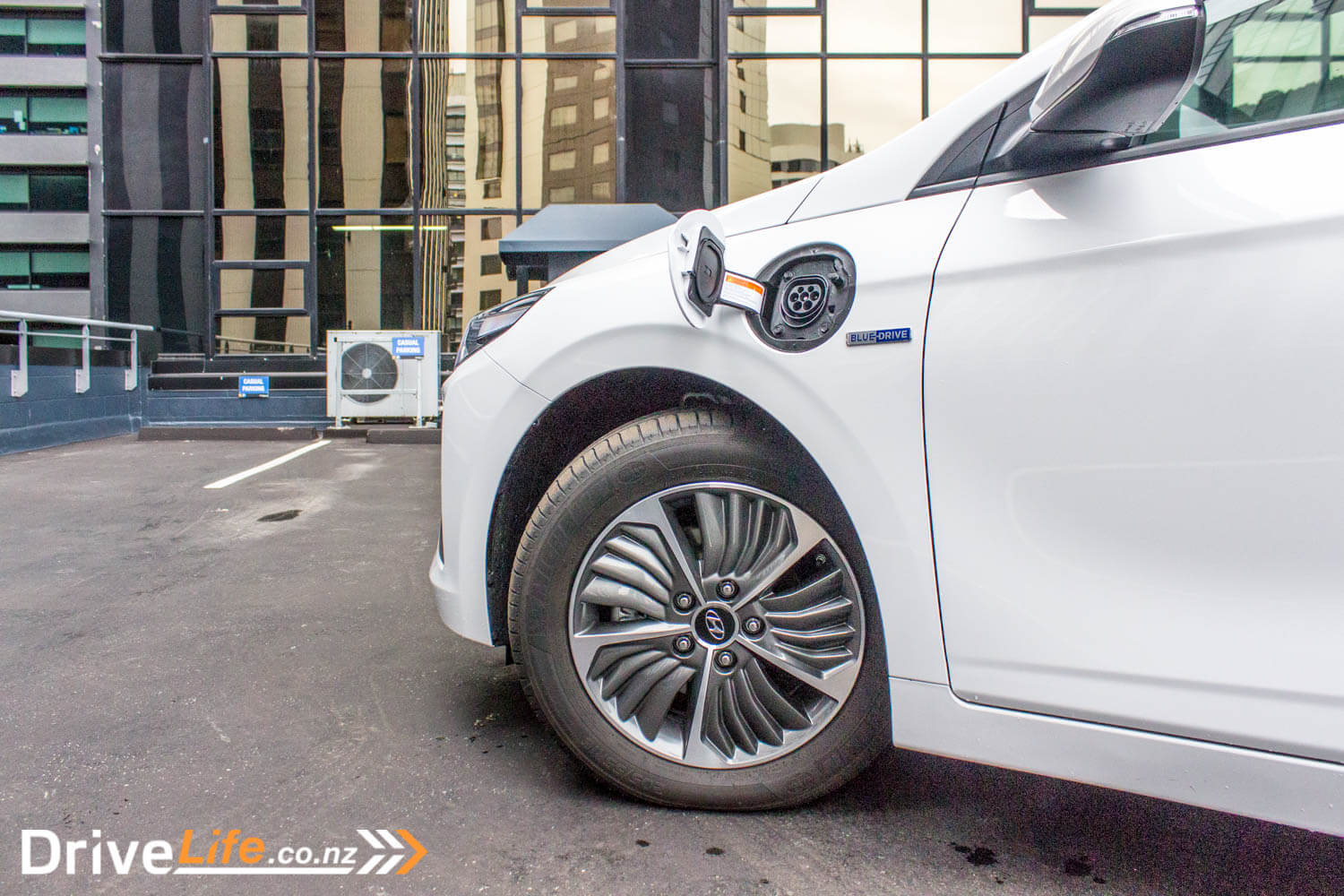
Great to see that the Entry model has adaptive cruise control, and it works very well. Again, comparing to Hyundai’s own Veloster, the Ioniq will bring the car to complete stop, and then restart with a touch of the gas pedal. That doesn’t happen in the Veloster.
During our couple of weeks with this car, fellow DriveLife reviewer Rob Clubley took the Ioniq away for the weekend, covering over 500km. He was heading off the grid, so didn’t charge the car at all on the whole trip, instead running the car in Hybrid mode the entire time. His fuel economy for that weekend away was 4.3L/100km, not too bad for a car this size.
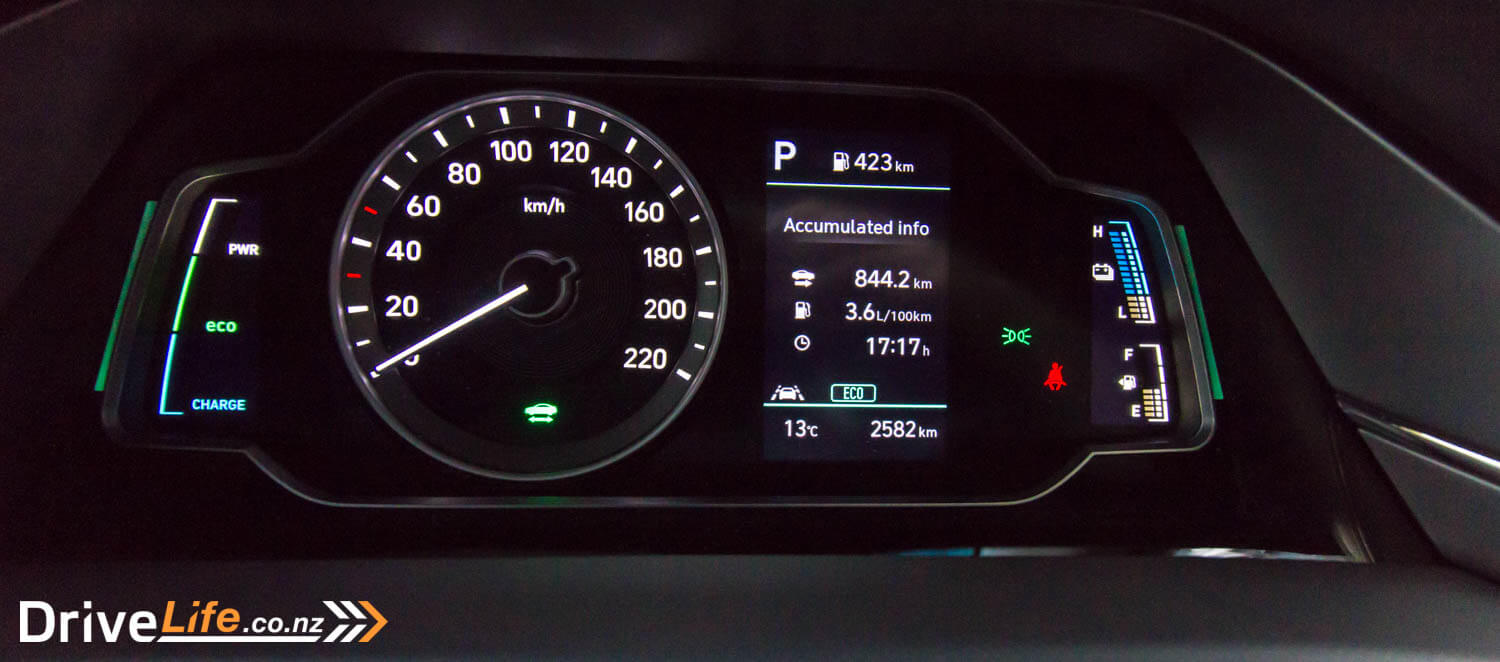
So what about fuel economy overall? For my first 175Km, I managed 1.8L/100Km, and then at the end of our test, after covering over 900Km, our average was 3.4L/100km. Pretty impressive, but a few hundred percent short of Hyundai’s claim of 1.1L/100Km. But still, after my 900Km in the car, there was over 350km of petrol left in the tank. The Ioniq PHEV looks like it can easily achieve a 1200Km+ range on a tank of gas from its 43-litre tank.
And what about comparing it to the Prius Prime, Toyota’s PHEV? I really enjoyed my time in the Prime, and it was the first car that sold me on PHEV. Toyota claim a combined fuel consumption for the Prime as 1.0L/100km. I didn’t achieve that, instead getting 2.3L/100Km. Also in comparison, at least the Ioniq has 5 seats, compared to the Prime’s 4.
The Competition
| Brand/Model | Engine | Power/Torque kW/Nm (combined) | Battery capacity, k/W/h | Cargo capacity, litres | Fuel consumption, L/100km | Price |
| Kia Niro PHEV | 1.6-litre, 4-cylinder petrol/hybrid | 104/147 | 8.9 | 324 | 1.3 | $55,590 |
| Hyundai Ioniq Entry PHEV | 1.6-litre, 4-cylinder petrol/hybrid | 121/317 | 8.9 | 341 | 1.1 | $53,990 |
| Prius Prime (base) | 1.8-litre, 4-cylinder petrol/hybrid | 90/142 | 8.8 | 302 | 1.0 | $47,490 |
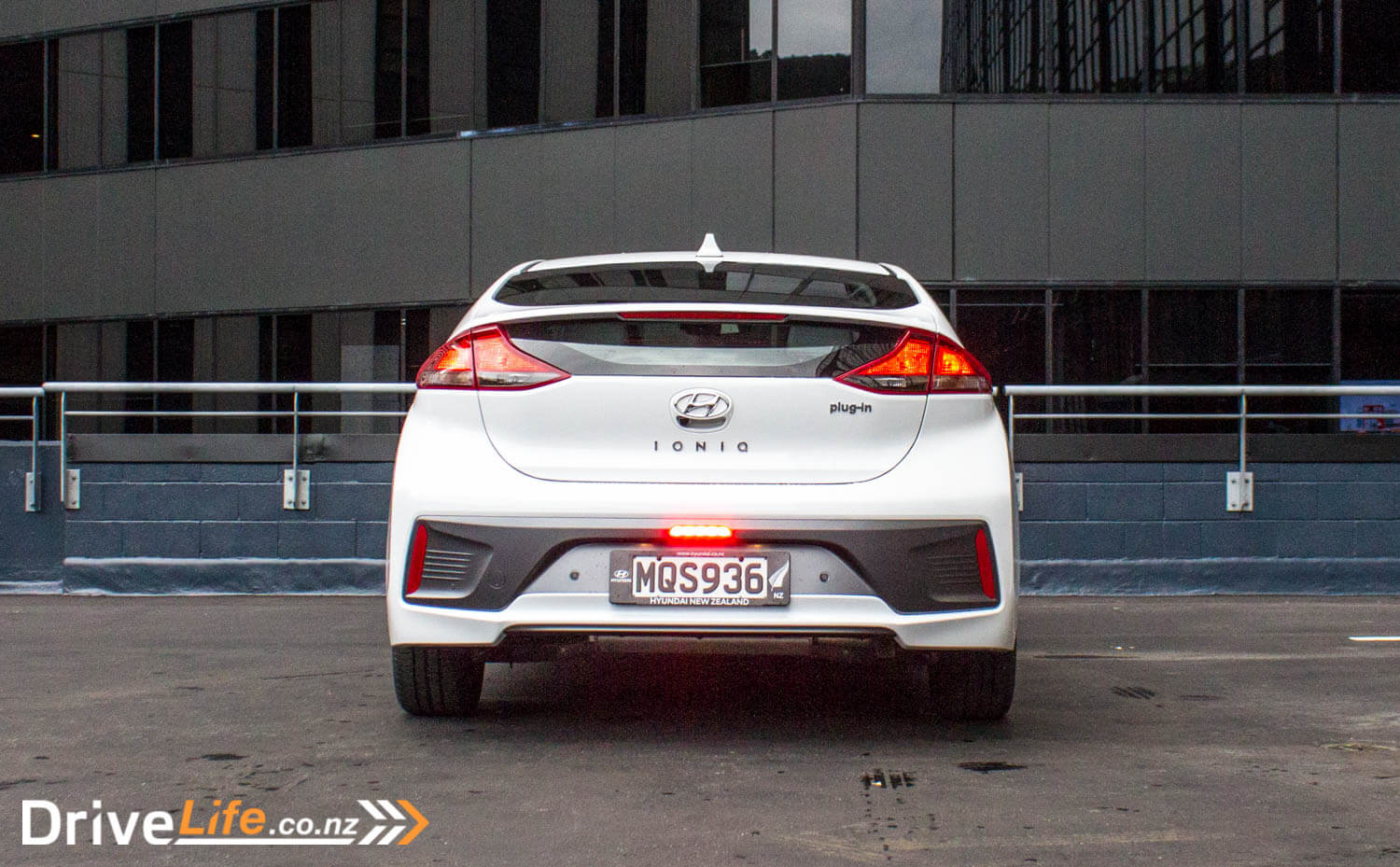
What’s The Pros And Cons For The 2020 Hyundai Ioniq PHEV Series II?
PROS
- Fuel economy
- Visibility
- Performance in Sport mode
- Driveability
- Battery-only range
- Ride
- Bright, airy interior
CONS
- A bit lethargic in Eco mode
- Rear window demister operation
2020 Hyundai Ioniq PHEV Series II – Specifications
| Vehicle Type | 5-door medium hatchback |
| Starting Price | $53,990 |
| Price as Tested | $53,990 |
| Petrol engine | 1.6-litre, four-cylinder petrol/hybrid |
| Transmission | 6-speed DCT |
| Power, Torque kW/Nm | Petrol engine: 77/147 Electric motor: 44.5/170 |
| Spare Wheel | Pump only |
| Kerb Weight, Kg | 1,495 |
| Length x Width x Height, mm | 4470x1820x1460 |
| Cargo Capacity, litres (seats up/seats down) | 341/1401 |
| Fuel economy, litres/100km | Advertised Spec – combined – 1.1 Real World Test – combined – 3.4 |
| Electric only range, WLTP | 52Km |
| Tank capacity, litres | 43 |
| Battery Capacity, kWh | 8.9 |
| Towing Capacity Kg, unbraked/braked | 750/NA |
| Turning circle, metres | 10.6 Small: 6-10m / Medium 10-12m / Large 12m+ |
| Warranty | 10 year / 200,000 km anti perforation corrosion body warranty 10 year / 160,000 km high voltage battery warranty 3 year / 100,000 km mechanical warranty 3 year / 100,000 km roadside assistance package |
| ANCAP Safety Rating | 5 Star |


